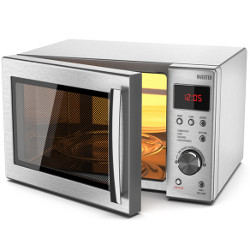
What is common between microwaved popcorn and WiFi networks? They both require microwave signals with frequencies around 2.45GHz. Indeed, research in the wireless networking community has demonstrated that microwave ovens, when turned on, can and do interfere with nearby WiFi networks and degrade their throughput. Thankfully, over the past two decades, the shielding of microwave ovens has improved, and WiFi networks have become smarter in combatting interference. So, it seemed the competition for airspace between microwave ovens and WiFi is from a bygone era until recently, when microwave ovens made a comeback to the wireless and mobile networking community.
Surprisingly, this time around, microwave ovens did not come back to interfere with WiFi networks. Rather, researchers figured out a way to program microwave ovens to heat food more evenly. We have all faced situations when a microwaved meal turned out unevenly heated, under-cooked, or overcooked. Microwave oven designers try to combat this by using turntables and placing reflectors inside the oven to distribute the microwave energy when heating food more evenly. However, these approaches are inherently limited when it comes to meals that combine different types of food (vegetables, rice, meat), each of which requires different amounts of time to warm up without burning or overcooking.
So how can wireless research help? Over the past two decades, the wireless networking community has made significant strides in understanding the physical layer of WiFi networks by playing around with software-defined radios. This understanding has resulted in highly effective solutions, which have made it to state-of-the-art WiFi standards, including WiFi 6 (802.11ax). Much of these improvements are driven by the ability of a WiFi sender and receiver to exchange information about the wireless channel to better direct their energy toward each other, thus driving throughput gains through a feedback mechanism (specifically, by sharing channel state information). Contrast this to microwave ovens that have no feedback mechanism and still operate blindly with respect to the food in the oven.
By measuring the amount of glow and its distribution across each tiny lamp, the microwave oven can automatically sense heat gradients and control its turntable to heat food more evenly.
The following paper makes an exciting leap by introducing a similar feedback mechanism to microwave heating through a technique the authors call software-defined cooking. At the core of this technique is an ability to directly measure the amount of heat delivered at different areas in a microwave oven and feed this information back to a turntable controller. To do this, the authors place an array of tiny neon lamps on the turntable; these lamps power up using the electromagnetic energy emitted by the microwave and glow in proportion to this energy. By measuring the amount of glow and its distribution across each of these tiny lamps, the microwave oven can automatically sense heat gradients and control its turntable to more evenly heat food placed in it. The authors built on this core idea to realize a system that can monitor temperature gradients even when the neon lights are in non-line-of-sight with respect to an external camera. They demonstrated how one can use their technique to heat food more evenly or heat different regions of a meal according to a recipe.
While there are many challenges before a moonshot idea like the one proposed in this paper makes it to a commercial product, the authors present an exciting direction to close the loop on microwave oven heating. It also opens the door to adopting various sophisticated techniques from wireless networking—such as MIMO beamforming, precoding, and sensing—to software-defined cooking. Perhaps future microwave ovens may even fuse sensed information from antennas and cameras inside the oven to execute highly sophisticated recipes. For now, I invite you to munch on a perfectly popped bag of popcorn as you read this paper and envision how learnings from wireless networking can help improve the design of microwave ovens.



Join the Discussion (0)
Become a Member or Sign In to Post a Comment